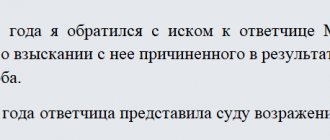Distinctive features
Claim proceedings in civil proceedings have a certain means of appeal to a legal authority. It constitutes the basic prerequisite for the commencement of proceedings. Special claims proceedings do not involve disputes of law. As a result, there are no parties expressing opposing interests. Violation or non-fulfillment of the rights of any individual triggers legal proceedings in civil proceedings. In this case, the person is forced to turn to a third, impartial party. She must sort out the dispute. The parties and the legal authority, acting as correlative, interfacing elements, constitute the essence of the claim proceedings. In this case, the presence of one person presupposes the presence of a second person performing the opposite task.
The procedure for considering such cases
Even the most complicated cases of special proceedings are studied according to the same scheme as issues relating to claim proceedings. In both situations, the following general requirements can be noted:
- to prepare to initiate a case;
- to conduct the process;
- to the rules for the applicant to prove his case;
- to the evidence base;
- to the decision made in the initiated case;
- to review decisions made by the court by filing a cassation.
Such processes are considered according to the rules inherent in civil proceedings. But due to the fact that in a case of special proceedings the parties cannot be identified (there is no defendant), some procedural features are highlighted here:
- To initiate a case of special proceedings, an application, not a lawsuit, is submitted to the court.
- The results of studying cases of special proceedings cannot be:
- waiver of claim (demand);
- signing of a settlement agreement;
- full or partial recognition of the claim;
- change in the previously raised grounds for filing a claim and its subject matter;
- filing counterclaims, etc.
- the applicant directly;
- other interested parties.
Only a limited number of citizens can go to court if a case of special proceedings is being considered.
For example, a person was declared dead. At the time when he was finally able to declare himself, his relatives had already divided his property, and his wife managed to remarry during his absence (his disappearance, allegedly related to his death).
In this situation, a competent lawyer will first be required to help restore the citizen to his civil rights. There is no one to make a claim here, since circumstances are to blame for the current situation. The citizen is recognized as alive in court.
And then a highly qualified lawyer, who has undertaken to solve the problems of this person, will need to recover all the property divided by relatives, sold by them, or missing property.
But to do this, you will have to file a lawsuit against relatives who are delaying the process of returning property. It may also be possible to recover funds that became an acquired benefit during the period of use of the property. This could be payment for renting an apartment.
As for the ex-wife’s new marriage, in this situation the recognition of the marriage with the new husband as invalid is permissible only with her consent. However, she will also have to return the embezzled property that previously belonged to the rightful owner - her ex-husband.
That is why, when a dispute arises about the law in a special proceeding case, the court leaves this case without consideration. Next, the applicant will need to file a claim in a court of general jurisdiction.
It should be noted that it is not necessary to initiate legal proceedings specifically on a claim only in cases where we are talking about declaring a person incompetent, or the case concerns a partial restriction of legal capacity.
A civil lawyer, whose services it is advisable to use, is sure that in special proceedings there are no simple, standard cases. There have even been cases in judicial practice, the decision on which was subsequently extremely difficult to implement. Sometimes it was necessary to initiate a new trial.
In addition, when clients solve their life issues, it is not always possible to find exact precedents. This task can only be accomplished by an experienced lawyer with extensive and long-term practice.
Controversial State
The concept of litigation requires the presence of at least two disputing parties. In this case, one makes demands, and the other answers them. Accordingly, the first acts as a plaintiff, and the second as a defendant. Claim proceedings are adversarial in nature. This is due to the existence of a dispute about interest (right).
Claim proceedings provide for various outcomes of the proceedings. In particular, these include a settlement agreement, a reduction or increase in requirements, the opportunity to file a counter-complaint, etc. Ensuring the claim proceedings is carried out at the expense of the relevant institution. Art. speaks about this. 139 Code of Civil Procedure. In particular, it says that the judge (court), at the request of the persons participating in the dispute, or on its own initiative, can take measures to secure the claim. The presence of this legal institution most of all guarantees the possibility of realizing the right to defense.
Signs of claim proceedings
They form clear differences between this type of proceedings and others. These include:
- Presence of a mandatory composition of subjects. It includes parties (defendant and plaintiff) who have opposing legal interests.
- Availability of material and legal requirements. It arises from the disputed or violated right of one of the parties. In this case, the claim is subject to consideration through a special form - a claim.
- The presence of a dispute over a subjective right or legally protected interest.
- Providing the parties to the dispute with certain guarantees. At the same time, they have equal rights during the proceedings.
- The ability to present a counterclaim, which acts as a measure to protect disputed/violated rights or interests protected by law.
- The presence of an adversarial nature of dispute resolution. In this case, the proceedings are based on the principle of dispositivity.
- The ability to dispose of material rights involved in the process. This clause is implemented by concluding a settlement agreement, reducing or increasing requirements. Also, a method of disposing of a disputed right is the termination of the claim proceedings. It may be subject to waiver of requirements.
Functions
Timely and correct consideration of disputes, their resolution to ensure the protection of a disputed or violated right, legitimate interest or freedom of a person, organization, state, its subjects, municipalities and other participants in labor, family and other legal relations are the main tasks that claim proceedings must perform.
Articles of the Code of Civil Procedure, therefore, name the most significant and fundamental goal of this type of proceedings to ensure the protection of the rights and interests of individuals and organizations protected by law. In fulfilling their functions, legal authorities contribute to the correct understanding and implementation of norms and the formation of the direction of legal practice. The decision taken on the dispute acts as an act of justice. It is issued by the appropriate authority on behalf of the state.
Objectives of civil procedure
In accordance with Art. 2 of the Code of Civil Procedure of the Russian Federation, the tasks of civil proceedings are the correct and timely consideration and resolution of civil cases in order to protect violated or disputed
- rights, freedoms and legitimate interests of citizens, organizations,
- rights and interests of the Russian Federation, constituent entities of the Russian Federation, municipalities,
- the rights and interests of other persons who are subjects of civil, labor or other legal relations.
Objectives of civil procedure:
- correct and timely consideration and resolution of civil cases (in order to protect violated or disputed rights, freedoms and legitimate interests);
- strengthening law and order, crime prevention;
- developing a respectful attitude towards the law and the court.
Purpose of civil process:
- protection of violated or disputed rights, freedoms and legitimate interests of citizens, organizations, public legal entities, and other persons who are subjects of civil, labor or other legal relations.
Note
Some authors (see, for example, Mokhov A.A., Vorontsova I.V., Semyonova S.Yu. Civil process (civil procedural law) of Russia: textbook / executive editor A.A. Mokhov. - M .: LLC "LEGAL FIRM CONTRACT", 2021. - 384 pp. 375), the following tasks are distinguished:
- main ones:
- protection of violated and contested rights, freedoms and legitimate interests of citizens, organizations, rights and interests of the Russian Federation, municipalities, and other persons who are subjects of civil, labor, and other legal relations.
- derivatives:
- strengthening the rule of law;
- crime prevention;
- developing a respectful attitude towards the law and the court.
However, if we define the goal as the final result towards which any process is deliberately directed, as a imagined and desired future event or state, then such a division contradicts Art. 2 of the Code of Civil Procedure of the Russian Federation and it seems to me not entirely correct.
Remedy
It is directly represented by a demand – a claim. The considered form of protection of interests and rights is considered the most suitable for the proper consideration and resolution of disputes with decision-making. According to statistical data, claim proceedings have a prevailing importance among other types. With the help of the protective equipment used in it, the safety of various aspects of society is ensured. In particular, this concerns the relationship between consumers and persons performing work (service), intangible benefits (honor, reputation, dignity) and other things. A citizen - an ordinary individual - always acts as a participant in these legal relations. Often it does not have the appropriate level of legal knowledge, which would allow it to independently protect and ensure the safety of its interests and rights.
Procedure for claim proceedings
Within the framework of legal discipline, the features of the considered form of ensuring and protecting interests and rights have been studied quite fully. In this regard, certain rules of claim proceedings have been developed. They are consistently defined by the rules of law. In particular, it is prescribed that the parties to the dispute can independently or through their legal representatives participate in the consideration of claims in the courtroom. At the same time, they are provided with sufficient legal grounds to influence the course of the proceedings and demand a legally correct decision. The consideration of the dispute begins by accepting the statement of claim for production.
The party whose rights or interests were limited or violated thus presents its claims. The application is drawn up according to the template established by law. Over a certain period, the legal authority examines the provided papers and checks their accuracy. Once the authenticity of all materials has been established and the requirements comply with the letter of the law, the first meeting is scheduled. There are disputing parties present. Participants are summoned by sending subpoenas.
During the hearing, the plaintiff presents and substantiates his demands. At the end of the hearing, the court makes a decision. The judge can satisfy the requirements or refuse to fulfill them. The parties have the right to appeal the decision to a higher authority. If there is an insufficient number of materials or if new ones appear, the court has the right to postpone the hearing for a more detailed study of newly received information. The parties may also come to an amicable agreement. In this case, the requirements will be partially satisfied.
The Supreme Court did not allow special proceedings to be passed off as claims
Last name change
After the death of Faina Pochuevskaya*, her daughter Nina* applied to accept the inheritance, and her son Arkady* submitted a document renouncing the inheritance. It turned out that their birth certificates indicate Faina Kareeva* as their mother, but there are no other documents that indisputably confirm the fact of relationship. Therefore, the notary refused to issue Nina a certificate of inheritance according to the law. Then Arkady and Nina applied to the court to establish the fact of a family relationship between them and the deceased.
Case No. 5-КГ19-8
APPLICANTS: Nina and Arkady Pochuevsky*
ESSENCE OF THE DISPUTE: Application to establish the fact of family relations
DECISION: The appeal ruling is cancelled, the decision of the court of first instance is upheld
The Izmailovsky District Court of Moscow found that the applicants’ mother did not change her surname after registering the marriage, but did so later and in 1951 registered at her place of residence as Pochuevskaya. According to the explanations, the applicants are each other’s siblings, and Faina Pochuevskaya, indicated in their birth certificates as Kareeva*, is their mother. Therefore, the trial court granted the application.
The Moscow City Court listened to the objections of the Moscow City Property Department, which insisted that there was a dispute between the applicants about the right to inheritance in the form of an apartment. The court came to the conclusion that the case is subject to consideration and resolution in the manner of claim proceedings. Therefore, the appeal overturned the decision of the court of first instance and left without consideration the application to establish the fact of family relations.
The Supreme Court examined the documents presented by the applicants, from which it is clear that the deceased never owned the disputed housing: after privatization, 1/3 of the apartment went to Nina, 1/3 to Arkady, 1/3 to their relative. There is no dispute about the right to inherited property in the form of an apartment. Therefore, according to the Supreme Court, there are no grounds for canceling the decision of the trial court. The Supreme Court overturned the appeal ruling of the judicial panel in civil cases and upheld the decision of the first instance court (No. 5-КГ19-8).
Expert opinion: confusion of terms prevented
Member of the Council for Interaction with Civil Society Institutions under the Chairman of the Federation Council, Yevgeny Korchago, said: documents that indisputably establish kinship include a birth certificate indicating the testator as parents or a court decision establishing paternity (maternity) in relation to the heir and the testator. In the absence of documents that indisputably confirm the relationship, the notary refuses to issue a certificate of inheritance according to the law. The notary's refusal can be appealed in court. At the same time, it is possible to establish the presence of family ties even after the death of a citizen, but only if there is no dispute about the right and the relationship cannot be confirmed in any other way.
The confusion of the concepts of “establishing a fact on which the establishment, change or termination of property rights depends” and “dispute about the right” led to a significant violation of the norms of substantive law, which the Supreme Court drew attention to.
Natalya Bokova, lawyer, partner of AB Kazakov and partners Kazakov and partners Federal rating. Antitrust Law group (including disputes) Bankruptcy group (including disputes) Natural Resources/Energy group Criminal Law group 22nd place By revenue per lawyer (more than 30 lawyers) 22nd place By number of lawyers 37th place By revenue Company profile
Senior lawyer of the commercial practice department of UB Padva and Epstein Padva and Epstein Federal rating. 29th place In terms of the number of lawyers, Margarita Sidorova noted that in the case considered, the establishment of the fact of family relations with the testator is not related to the dispute over the inclusion of property in the inheritance mass. “The position of the appeal is surprising, which apparently boiled down to an unsubstantiated belief in the statements of the City Property Department. Due to an error by the appellate court, the applicants were actually deprived of the right to consider the case. We can only regret that such an error was not corrected by the lower court,” says lawyer AB Kazakov and Partners Kazakov and Partners Federal Rating. Antitrust Law group (including disputes) Bankruptcy group (including disputes) Natural Resources/Energy group Criminal Law group 22nd place By revenue per lawyer (more than 30 lawyers) 22nd place By number of lawyers 37th place By revenue Company profile Elena Muratova.
“In practice, such statements occur quite often, but they do not cause any particular problems: the fact of family relationships is confirmed by documents and testimony,” said a lawyer at BMS Law Firm BMS Law Firm Federal Rating. Vladimir Shalaev. The opposite opinion was expressed by Rustam Ismailov, director of the private services department at 3B Consulting: “In such cases, judges often state that there is a dispute about ownership in order to change territorial jurisdiction or increase the amount of state duty, although such a requirement is not stated at all. As a result, you have to either appeal the court’s ruling or pay additional state fees.”
And Associate Professor of the Department of Legal Regulation of Economic Activities of the Financial University under the Government, Ph.D. n. Natalya Zalyubovskaya believes that cases of establishing facts of legal significance are the most common of special proceedings. If the establishment of family relations directly affects the rights of the city of Moscow, which claims real estate as escheat property, the courts refuse to consider cases, Zalyubovskaya said.
* – first and last names have been changed by the editors.
- Alina Mikhailova
Review time
The duration of the claim proceedings varies. However, the law establishes certain periods for the acceptance of demands, consideration of materials, hearings, decisions, and their entry into force. The statute of limitations for claims sets the limits within which one of the parties (or both) can appeal the decision, present counterclaims, abandon them or change them. After this period, the consideration will not be reopened, which implies the commencement of new proceedings.
The Doctrine of "Claim"
The concept of a claim as such has been known since Roman law. At the same time, the definition of claim that was given in ancient times has been preserved and is quite widely used today. In content, the claim represents the right of the subject to realize through legal order his own demand, will, desire. However, domestic researchers at the end of the 19th century pointed to the existence of two meanings.
In particular, a claim is an opportunity to legally defend an existing civil right through judicial proceedings. In accordance with the second meaning, a claim in this form represents a certain action of a person who has applied to the executive body so that it, in turn, obliges the defendant to fulfill what is due to him, or recognizes the right of the injured party. For a long time, Soviet procedural practice used an approach on the basis of which the claim was considered as an integral element with material and legal aspects. Today, the most general definition is that this form represents a claim from one person to another to protect a protected interest or opportunity. To present claims, the plaintiff applies to the court of first instance.
Claim or writ proceedings: what to choose
The choice of method for collecting debts in economic court depends, as a rule, on what documents the collector has. But in some cases you don't have to choose. Then the only option is a lawsuit.
1. General in writ and claim proceedings
Writ proceedings, like claims, are subject to the general rules of proceedings in the court of first instance (Article 217 of the Code of Criminal Procedure). This is for example:
- rule of jurisdiction. An application to initiate writ proceedings is submitted to the economic court of the region (Minsk) at the location or residence of the debtor (part 1 of article 48, part 1 of article 49 of the Code of Criminal Procedure). However, the parties can change the general rule of jurisdiction in the contract (Article 52 of the Code of Criminal Procedure). Contractual jurisdiction also applies to writ proceedings (Part 1 of Article 221 of the Code of Criminal Procedure).
Thus, the parties can stipulate that all disputes and disagreements are subject to the jurisdiction not of the economic court, but of the MAC at the BelCCI. At the same time, the presence of a prorogation agreement providing for the transfer of disputes to the court of another state; an arbitration or arbitration agreement in itself is not a basis for refusing to accept an application to initiate writ proceedings. However, the debtor, in his response to the application to initiate writ proceedings, may indicate that he does not agree with the consideration of the dispute in the economic court and refer to the existence of an agreement. Then the court will refuse to issue a ruling on the court order (part 3, paragraph 11 of the resolution of the Plenum of the Supreme Economic Council No. 21);
— rule for combining requirements. The requirements must be related to each other based on the grounds for their occurrence or based on the evidence presented (Part 1 of Article 165 of the Code of Criminal Procedure). But if one of the demands cannot be stated in writ proceedings, the court may refuse to satisfy all demands (Part 2 of Article 224 of the Code of Criminal Procedure).
The main requirement can be combined with the requirement to collect penalties (fines, penalties) and interest for the use of other people's funds. But the debtor must recognize them (not challenge them) (part 3, paragraph 5 of the resolution of the Plenum of the Supreme Economic Council No. 9). You may also be able to claim legal fees. To do this, it is necessary to prove that the debtor recognized them or does not dispute them (part 3, paragraph 22 of the resolution of the Plenum of the Supreme Economic Council No. 9);
— rules on limitation of actions, calculation of procedural deadlines, etc.
2. Advantages of writ proceedings over claims
At the heart of litigation is a dispute about law. Writ proceedings presuppose the absence of such a dispute. In addition, the main difference and advantage of ordering proceedings is saving money and time. The advantages are:
- in a smaller amount of state duty - a maximum of 7 BV versus a minimum of 25 BV in a claim;
— no travel expenses associated with sending a representative to court. In writ proceedings, the proceedings take place without calling the parties (part 1 of article 220 of the Code of Criminal Procedure, clause 1 of the resolution of the Plenum of the Supreme Economic Council No. 9). Only documents are examined;
- quick consideration of the application - within no more than 20 working days from the date of receipt by the court (part 3 of article 134, part 1 of article 225 of the Code of Criminal Procedure). The court may consider the claim for more than two months (Articles 169, 175 of the Code of Criminal Procedure);
— there is no need to wait for the final decision on the case to enter into force and receive a court order. The ruling on a court order comes into force from the moment it is issued and is an executive document (part 5 of article 225 of the Code of Criminal Procedure, paragraph 3 of part 1 of article 10 of the Law on Enforcement Proceedings).
In writ proceedings, it is not necessary to submit a claim before filing an application to initiate writ proceedings (paragraph 3, part 1, clause 11 of the resolution of the Plenum of the Supreme Economic Council No. 6). However, in many cases it is advisable to direct it. For example, in the case when there are no other documents confirming the debtor’s recognition of the debt (account reconciliation acts, etc.).
3. Nuances of writ proceedings
Despite many advantages over claim proceedings, the order has a number of disadvantages:
— it considers a limited range of requirements (parts 2 and 3 of Article 220 of the Code of Criminal Procedure). The debtor must clearly acknowledge the amounts being collected or fail to respond to a properly filed claim. In addition, one more condition must be met - an executive inscription cannot be made upon request;
- the debtor may abuse his right when submitting a response to the claimant’s application. Thus, it is enough to raise objections in the response, and the court will refuse to issue a ruling on the court order (paragraph 2, part 1, article 224 of the Code of Criminal Procedure). At the same time, objections must be justified and supported by evidence (Article 223 of the Code of Criminal Procedure). For example, the debtor, citing partial fulfillment of the obligation, may point out the disproportionality of the collected penalty (Article 314 of the Civil Code);
— the court has the right to refuse to satisfy all claims if the debtor recognizes only part of them in the response. In this case, satisfying part of the demand is not an obligation, but the right of the court (Part 2 of Article 224 of the Code of Criminal Procedure);
— the claimant cannot provide additional evidence. All evidence is initially attached to the application to initiate writ proceedings (clause 10 of the Resolution of the Plenum of the Supreme Economic Council No. 9). No additional submissions are required.
4. Requirements that are not considered in writ proceedings
These are the requirements:
- for which an executive inscription is possible:
- on reclaiming real estate;
— on the fulfillment of a guarantee obligation (with the exception of a bank guarantee);
- on the fulfillment of an obligation arising from an agreement on the assignment of a claim or on the transfer of a debt. The exception is cases of written recognition of debt by the debtor (part 3 of article 220 of the Code of Criminal Procedure, part 2 of clause 2 of the resolution of the Plenum of the Supreme Economic Council No. 9));
- to a person who is in the process of liquidation or against whom bankruptcy proceedings have been initiated and bankruptcy proceedings have been opened;
- to a foreign person;
— to a branch (structural unit) of a legal entity.
5. Cases when writ proceedings are used
In writ proceedings, you can not only recover money, but also reclaim property (except real estate) or foreclose on it (part 2 of article 220 of the Code of Criminal Procedure, clause 1 of the resolution of the Plenum of the Supreme Economic Council No. 9).
It is advisable to contact the bailiff if the debtor admits or does not dispute the demand, but does not fulfill it (Part 2 of Article 220 of the Code of Criminal Procedure). Recognition will confirm:
- a response to a claim in which the debtor acknowledges the debt;
— act of reconciliation of settlements, signed by authorized persons of the parties;
— an accepted payment request, another document drawn up in accordance with the law and signed by an authorized person of the debtor (part 2, paragraph 5 of the resolution of the Plenum of the Supreme Economic Council No. 9).
The non-contestation of the claim will be confirmed by an unanswered claim (Part 2, Clause 5 of the Resolution of the Plenum of the Supreme Economic Council No. 9). In this case, it is necessary to prove that the debtor:
— received a claim (for example, attach a postal notification);
- evades receiving the claim or has not received it for other reasons (you can attach, for example, a copy of the claim, postal receipts for sending it to the legal address of the debtor, an extract (certificate) from the Unified State Register about the location of the debtor (part 3, sub-clause 1.8, p. 1 letter of the VHS N 02-38/380)).
However, it should be remembered that debts that can be collected with the help of a writ of execution are not considered in writ proceedings (Part 3 of Article 220 of the Code of Criminal Procedure, Part 2 of Clause 2 of Resolution of the Plenum of the Supreme Economic Council No. 9). List No. 1737 contains such requirements.
Based on the above, an order should be chosen when:
- the debtor did not respond to the claim sent to the legal address (the address agreed upon in the agreement) and did not sign the statement of reconciliation of payments;
- the debtor acknowledged the debt in response to the claim or signed an act of reconciliation of settlements and the agreement (demand) is not in list No. 1737, and an executive inscription is impossible;
- the agreement (demand) is in list No. 1737, but the claimant does not have all the necessary documents or their originals to complete the writ of execution;
— interest recognized (not disputed) by the debtor is collected (except for interest under the leasing agreement).
6. Situations when, instead of an order, a writ of execution is needed
In writ proceedings, the requirements for which a writ of execution is possible are not considered (part 3 of article 220 of the Code of Criminal Procedure, part 2 of clause 2/ilexlink of the resolution of the Plenum of the Supreme Economic Council No. 9). These are indisputable requirements specified in list No. 1737. Moreover, the requirement is recognized as indisputable if all the documents listed in list No. 1737, including their originals, are available.
A writ of execution, rather than a writ of writ, should be used when:
the principal debt or penalties are collected, but not interest (except for interest under a leasing agreement);
the agreement (demand) is in list No. 1737;
the requirement is indisputable and the claimant has all the documents necessary according to list No. 1737, including originals, for example:
- response to a claim with recognition of debt, acts of reconciliation of calculations - in the case of debt under contracts of sale, supply, contract, transportation, provision of services, storage;
- transfer deed or other document on the transfer of premises with signatures of the parties - in case of debt for the lease of non-residential premises
7. Cases when only claims proceedings remain
The claimant, despite the existence of grounds for initiating writ proceedings, has the right to present claims in the manner of claim proceedings (ilex_link link=»https://ilex-private.ilex.by/view-document/BELAW/112684/#M100012″part 2 p 3 resolutions of the Plenum of the Supreme Economic Council No. 9). However, the requirements for which a writ of execution is provided, in the presence of all documents confirming their indisputability, are not considered in court. And not only in writ proceedings, but also in claims (parts 1 and 2, paragraph 2 of Decree No. 366, part 2 of Article 164 of the Code of Criminal Procedure).
Claim proceedings remain the only way to collect debt in situations where:
— there is a dispute about the law. For example, the debtor disputed the claim in the response to the complaint;
— the notary refused the writ of execution;
- in writ proceedings, the court refused to issue a ruling on a court order (for example, in connection with the debtor’s objections).
Read this material in ilex >>* *follow the link you will be taken to the paid content of the ilex service
Researchers' opinions
The point of view that the requirement to protect substantive rights and interests belongs to the substantive side, and an individual’s appeal to the court with a request to preserve his own right belongs to the procedural and legal side, was held by Chechot, Ivanova, Dobrovolsky and other specialists. Another group of scholars has defended the idea that a claim has two meanings.
In particular, researchers such as Pyatiletov, Bonner, Shakaryan, Gurvich and others argued that the concept of a claim should be considered from both the substantive and procedural aspects. In the first case, we are talking about the right to satisfy the demands themselves, in the second - about applying to the first instance authority with a request for protection. Another group of specialists considered the claim as a category of procedural civil law. This idea was adhered to by Komissarov, Semenov, and Yudelson. The claim is a provoking factor for the start of the process, because it submits the dispute to the competent authority.
Types of proceedings and stages of civil proceedings
Types of production
The type of proceedings is determined by the substantive nature of the cases and is characterized by independent means and methods of protecting rights and interests, as well as the ensuing features of the judicial procedure.
Types of civil proceedings are:
- claim proceedings - aimed at resolving disputes between individuals regarding subjective rights and obligations;
- writ proceedings - simplified proceedings to protect rights based on indisputable evidence;
- special proceedings - there is no dispute about the law;
- proceedings in cases arising from public law relations - (subsection III of the Code of Civil Procedure of the Russian Federation has lost force since September 15, 2015 - Federal Law dated 03/08/2015 N 23-FZ).
Comment
Some authors include writ and absentee proceedings as part of the claim, distinguishing only two types:
- claim;
- special.
However, if it is possible to agree with the inclusion of absentee proceedings in the composition of the claim, then it is unlikely to agree with the inclusion of an order.
See Mokhov A.A., Vorontsova I.V., Semyonova S.Yu. Civil process (civil procedural law) of Russia: textbook / rep. ed. A.A. Mokhov. - M.: LLC "LEGAL FIRM CONTRACT", 2021. - 384 p. P.27.
The increase in the number of types of legal proceedings, on the one hand, has significantly complicated the judicial process, but on the other hand, the process has become more flexible, it better takes into account the characteristics of individual categories of civil cases.
See also Resolution of the Plenum of the Supreme Court of the Russian Federation dated December 27, 2021 No. 62 “On some issues of application by courts of the provisions of the Civil Procedure Code of the Russian Federation and the Arbitration Procedure Code of the Russian Federation on writ proceedings”
Stages of civil proceedings
Civil proceedings represent the movement of a civil case in court, a certain set of stages (stages) of its consideration and resolution.
The stage of the judicial process is a certain part of the process, a set of actions and decisions aimed at achieving the goal of this stage of legal proceedings. Has its own
- goals and objectives,
- circle of participants,
- terms, actions and legal relations,
- decisions and documents.
The stages of civil proceedings develop in a strictly defined sequence, one stage follows another and becomes possible only after the creation of certain conditions.
Correlation of definitions
Many people believe that concepts such as “claim” and “statement of claim” are equivalent. However, even after a superficial analysis, the opposite becomes clear. The statement of claim is presented as a more static (conservative) element. It acts as a "form". The claim is the direct content of the demand. It has a dynamic (reformative) character. If the content changes by replacing elements or clarification, the statement of claim will remain unchanged until changes in one claim lead to the drawing up of a new one in its place.
When analyzing the relationship between form and essence, one should remember the relative independence of these components. This is indicated by an assessment of procedural norms that provide institutions for recognition, provision, separation and connection of the content of requirements. The latter are considered the most striking example confirming the thesis about the relative independence of form and content. This, in turn, allows us to justify the need to conduct claim elements in an objective sense, and not from a subjective position focused on the actions of the interested party.
Right to determine a claim
It belongs exclusively to the plaintiff. Moreover, without his consent, adjustments cannot be made to the basis and subject of the requirements. Of particular importance for correct decision-making is an accurate indication of the circumstances on the basis of which the plaintiff builds his claims. We are talking, in particular, about the legal facts that form the essence of the claim. In this case, it is necessary to indicate significant circumstances that will be included in the subject of evidence for consideration. In addition to the factual one, there is also a legal basis for the requirements. Claim proceedings in an arbitration court require the injured party to refer to the rule of law that ensures the safety of the violated interest.
The Code of Civil Procedure does not provide for such a need. However, the claim proceedings provide for an indication of the right whose protection the interested party requires. If the claim is drawn up by a lawyer, prosecutor, or legal adviser, then they should legally correctly define the disputed legal relationship and indicate the violated legal norm.
When can consideration of a dispute in summary proceedings violate the right to judicial protection?
On October 17, the Supreme Court issued Ruling No. 305-ES19-6722 on the dispute between Mosenergosbyt JSC and its counterparty, which was considered by the court of first instance in summary proceedings, despite the defendant’s objections.
In September 2021, Mosenergosbyt JSC filed a lawsuit against PJSC Sapphire Research and Production Enterprise to collect debt on electricity payments in the amount of 3.5 million rubles. The specified amount included the debt that was formed as a result of the enterprise’s failure to pay the invoice issued upon the discovery by the network organization of unmetered electricity consumption, and the legal penalty accrued on it.
The arbitration court accepted the company's claim for consideration through summary proceedings. Pointing out that the court had an interrelated case No. A40-165823/2018 on the claim of the enterprise against the company, the defendant during the trial petitioned to combine the cases into one proceeding. However, the court denied the motion and granted the claim by granting summary judgment.
As part of the appeal proceedings, the second instance established the fact of partial repayment of the debt to the plaintiff by the enterprise. Thus, the appeal overturned the decision of the trial court, accepting the plaintiff’s refusal of the claim regarding the principal amount of the debt in the amount of 3.3 million rubles. The appeal recovered only 397 thousand rubles from the defendant. legal penalties and the cost of paying state fees. At the same time, the appellate court did not reveal any violations of procedural law committed by the trial court.
Content elements
A claim is a legal, structurally complex entity. In this regard, the study of its components is of particular importance. The importance of highlighting the elements lies, first of all, in the fact that they act as the main criterion in determining the identity of claims, which, in turn, reflects the coincidence of the subject, parties and grounds of the claim. In this case, the first is considered the rationale for classifying claims in accordance with procedural and legal characteristics. The basis and subject form the boundaries of evidence, the framework of the trial. In domestic law in the 19th century, 3 components were distinguished:
- Legal basis.
- Contents (subject) of the claim.
- Factual basis.
Today, some authors highlight the following elements:
- Content.
- Item.
- Base.
- Legal qualifications.
- Parties.
However, many experts adhere to the division into two components: the basis and the subject of the claim. Let's take a closer look at them.
Claim proceedings are the main type of civil proceedings.
The bulk of civil cases considered by the courts are classified by law as claim proceedings.
Claim proceedings are the activities of the court provided for by the civil procedural law to consider and resolve substantive legal disputes arising from civil, family, labor, cooperative and other legal relations.
Claim proceedings are the main type of civil proceedings, establishing the most general rules of judicial proceedings. Filing a claim in litigation proceedings, as well as filing a statement in court in non-claim proceedings, is an integral element of a broader constitutional right - the right to apply to court for judicial protection, enshrined in Art. 46 of the Russian Constitution.
Thus, a claim is one of the main means of initiating civil proceedings in a specific case, in this case, litigation proceedings, which activates the mechanism of judicial activity and the administration of justice.
The following features are characteristic of a claim form of protection of rights:
1) the existence of a substantive legal claim arising from the violated or disputed right of a party and subject by force of law to consideration in a certain manner established by law, i.e. a claim;
2) the existence of a dispute about subjective law;
3) the presence of two parties with opposing interests, who are endowed by law with certain powers to protect their rights and interests in court.
The essence of the claim proceedings is that the court verifies the presence or absence of a subjective right due to uncertainty, challenge or violation on the basis of which the dispute arose.
The purpose of the claim proceedings is to protect subjective rights by recognizing them, awarding certain actions or abstaining from them, terminating or changing the legal relationship (Article 12 of the Civil Code).
The claim and its elements.
A claim in civil proceedings is an application to the court by an interested person with a demand for the protection of a violated or disputed subjective right or an interest protected by law by resolving a dispute about the right.
A claim serves as a procedural means of resolving a dispute about law between the parties to a substantive legal relationship.
The legislation allows us to distinguish three components in a claim: content, subject and basis (elements of the claim).
1) The content of the claim is the type of judicial protection sought by the plaintiff . The content of the claim is determined by the plaintiff based on the method of judicial protection provided for by law (Article 12 of the Civil Code).
Accordingly, the plaintiff may ask the court:
*on sentencing the defendant to perform a certain action;
*on recognizing the existence or, conversely, absence of any
legal relationship, subjective right or obligation;
*about the change or termination of the legal relationship between the plaintiff and the defendant or, as is commonly said in theory, about the transformation of the legal relationship.
2) The subject of the claim is understood as a specific demand of the plaintiff to the defendant , for example, for recognition of the right of authorship, for reinstatement at work, for compensation for damage, etc.
As emphasized in paragraph 4 of part 2 of Art. 131 of the Code of Civil Procedure, the plaintiff must indicate his claim in the statement of claim. The subject of the claim should not be confused with a specific material subject (object) of the dispute, i.e. money, things, apartment, etc.
The subject of the claim may be an interest protected by law (Article 152 of the Civil Code), as well as the legal relationship as a whole.
3) The basis of the claim is understood as the circumstances from which the right of claim of the plaintiff arises, on which the plaintiff bases them.
This understanding of the basis for the claim is directly indicated by clause 5, part 2, art. 131 Code of Civil Procedure. The plaintiff must indicate in the statement of claim not just the circumstances, but also provide legal facts, i.e., circumstances with which the law connects the emergence, change or termination of legal relations. These facts must then be proven by the plaintiff in civil proceedings.
Typically, the basis of a claim does not consist of one fact, but of some combination of them, corresponding to the hypothesis of the rule of substantive law and called the factual composition.
The elements of a claim are of great importance in civil proceedings. The elements of the claim are the main criterion in determining the identity of the claims, since the identity of the claims is determined by the coincidence of the subject, basis and parties to the claim.
Establishing the identity of claims is the basis for refusing to accept a statement of claim (Article 134 of the Civil Procedure Code), terminating the proceedings (Article 220 of the Code of Civil Procedure) or leaving the application without consideration (Article 222 of the Code of Civil Procedure).
The subject and basis of the claim determine the boundaries of the subject of proof, the limits of the trial
. The right to change them belongs only to the plaintiff. The court may go beyond the stated requirements in cases provided for by federal law (Part 3 of Article 196 of the Code of Civil Procedure). For example, according to paragraph 2 of Art. 166 of the Civil Code, the court has the right, on its own initiative, to apply the consequences of the invalidity of a void transaction.
Classification of the claim.
Like any other classification, the classification of claims contributes to their deeper study and facilitates the application of this institution. There are two systems for classifying claims, i.e. dividing them into types: *procedural-legal, which is based on a procedural-legal feature;
*material and legal, based on a material and legal characteristic. It has implications for judicial systems. The classification of claims based on material and legal grounds is of great practical importance.
In judicial practice, it is customary to separate cases into separate categories of material and legal relations: alimony, labor, housing, railway transportation, damage, etc.
The procedural-legal classification of claims, covering all possible legal methods of judicial protection, is exhaustive and therefore of primary importance in the theory of civil procedural law.
Claims according to this classification are divided into three types:
*claims for award;
*claims for recognition;
*claims for change or termination of legal relations (transformative claims).
Subject of requirements
It consists of substantive disagreements with the actions of the defendant. The nature of the claim is determined by the characteristics of the disputed legal relationship. From this, in fact, the requirement follows. The plaintiff’s request, implemented in this way, essentially forms the pleading clause of the application. The understanding of the position of the victim by the executive body will depend on the clarity and literacy of the wording of the requirement. According to Osokina, the subject of the claim, acting as an element of its content, characterizes it from the point of view of specific disagreement. A claim is not a subjective right to be protected, but a method to ensure it. The application should indicate evidence confirming the circumstances under which the dispute arose. However, the court cannot refuse to accept the claim due to their absence.
Legal qualifications
This element is highlighted by Amosov, one of the system’s researchers. However, according to Osokina, the allocation of legal qualifications only complicates the construction of the claim. However, in order to increase the effectiveness of legal protection, taking into account the realities of existing legal practice, which Amosov quite convincingly pointed out, adding an additional independent element could probably be advisable. This may become especially relevant later, when the convergence of arbitration and civil processes and their mutual enrichment are expected.








